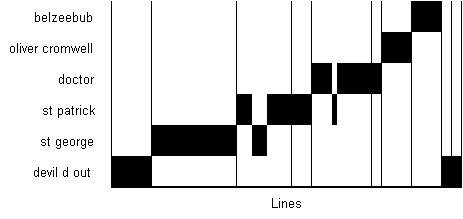"This is a Mummers’ play I wrote": Part 10 - Wexford Mumming Plays
Wexford Mumming PlaysThe folk plays of Wexford, Ireland show evidence of rewriting in the late 19th and early 20th centuries. There are three types of script in Wexford, the earliest being a traditional text. Examples of these are:
|
Observations on the Wexford Mumming PlaysThe most obvious change to be observed to have taken place during the rewriting of the Wexford plays is the increase in the length of the script. This is illustrated in Figure 11. Huddleston's text is over five times as long as the traditional Ballybrennan version, while the Patriot Rhymes are a further 50% longer that the Huddleston text. |
 Fig.11 - Lengths of the Wexford Mumming Plays |
Wexford CastsThe increased lengths of the plays are also reflected in the casts, with a double of the number of dramatis personae in the rewritten texts as follows:
There is an additional Irish character - the patriot Dan O'Connell - in the Huddleston text, but the theme of the play is the reconciliation of the differences between England and Ireland, as personified by Saint George and Saint Patrick, in order to fight foreign adversaries. Sinnott's "revisions and corrections" really amount to a total rewrite of the play. It is still a Quack Doctor Play, but has no textual similarity with the earlier play, although it is in rhyme, and the characters introduce themselves with "Here am I...". Tantalisingly, Huddleston's reconstructed text has just one couplet that is found in the earlier Ballybrennan text:
but this couplet does not appear in Evoy's Mummer's Rhyme sheet for The Doctor. It is therefore unlikely that it was in Sinnott's original script. Otherwise it would follow the practice of more modern Mummers' play compositions in retaining this verse. The Patriotic Rhymes are also a complete rewrite, although most characters still introduce themselves with the formula "Here I am..." As one would expect from the title, the characters are all famous Irish patriots, except for the Captain, who acts as the master of ceremonies. Again with the exception of the Captain, the patriots replace all the earlier dramatis personae, and there is overall an anti-English flavour to the script. Interestingly, Saint Patrick has been dropped in favour of a more home-grown Irish saint, Saint Columcille. More importantly, from the point of view of folk play history, the Doctor has also been dropped, taking with him the motifs of a dispute and the revival of the loser. These motifs are ubiquitous elsewhere, so their omission is highly significant. In fact, the Patriotic Rhymes are not really a play at all in the usual sense. Instead they embody a procession of characters, who merely introduce and describe themselves (albeit at length), and do not engage in dialogue with each other. What is barely evident from the text is that the Mummers who perform these rhymes also perform characteristic dances. These are performed in sets, and involve the clashing of special Mummers' sticks in a manner that is redolent of the clashes in English sword and morris dances. These dances have arguably become the principal feature Mumming in Wexford today. |
Structures of the Wexford PlaysFigures 12 to 14 show graphs of the structures of the three types of Wexford play, plotted using the method already described when discussing the Eastwood plays. They have had to be plotted to differing scales, but they nonetheless exhibit some interesting trends and similarities. |
 Fig.12 - Ballybrennan, Wexford play - about 1823 - P.Kennedy (1863) |
|
As with the Eastwood plays, the structure of the Ballybrennan text conforms to the type of folk play where lines are focused on the most recent character, with very little in the way of real dialogue. The play is little more than a steady procession of personages, an interpretation that is supported by the straight near-diagonal arrangement of the speeches in the graph. Another feature worthy of note is that the same character, Devil D'out, both introduces and concludes the play. |
 Fig.13 - Wexford Mummers' Play (Collected by N.A.Huddleston) - J.Parle (2001) p.295-305 |
|
Huddleston's text has more real dialogue than the Ballybrennan play, especially for the scene involving the Doctor. Even so, the graph shows that the lines are also focused on the most recent characters, again with a relatively steady procession of personages. The Captain both introduces and concludes the play, just as Devil D'out does in Ballybrennan. So, while Sinnott appears to have introduced more dramatic sophistication into his script, he also seems to have retained the basic structure and dramaturgy of the earlier play. |
 Fig.14 - Patriotic Rhymes - J.Parle (2001) pp.316-329 |
|
The structure of the Patriotic Rhymes is clearly just a procession of characters with speeches of approximately equal length. Two brief interjections by the Captain are the nearest we get to dialogue. They are used to enable the characters Sarsfield and Father Murphy to answer accusations of non-patriotic acts. As with Huddleston's text, the Captain acts as the master of ceremonies and he both introduces and concluded the performance. |
Overall Trends in WexfordThe chronological trends within the Wexford Mumming tradition are for the texts to increase in length, and for the characters and subject matter to become more patriotically Irish. On the other hand, the overall structure of the plays has been retained throughout, with one character acting as master of ceremonies. The main aim of the Mumming tradition in Wexford appears to be to present a procession of interesting personages, rather than to present a drama per se. The characters are the main thing, and such plot as there is is subsidiary. |